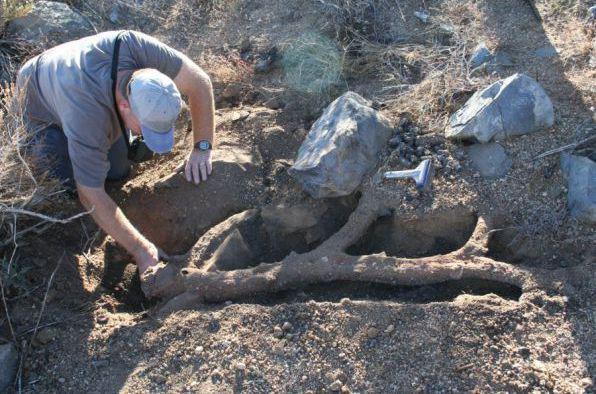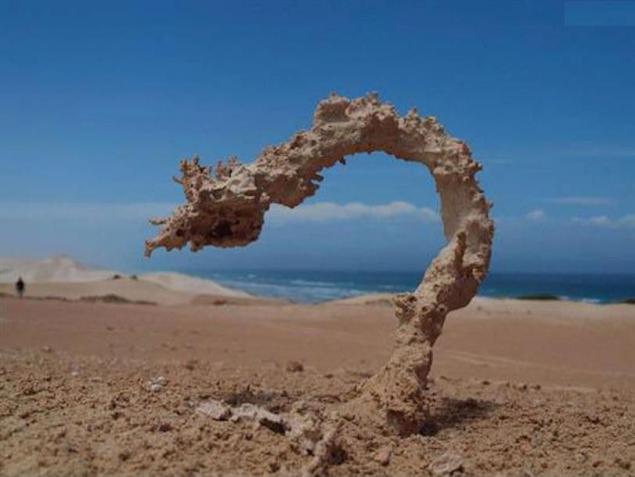1753
Guess what happened to the sand?
Everyone in my childhood did figures from the sand, just dripping wet sand from the top. But it is not human hands, the solution inside the post.

This lightning strikes sand or sandy ground, then formed fulgurite.

Fulgurite - (from the Latin. Fulgur - thunderbolt + Gr. -eids - Like) - sintered lightning SiO2 (sand, quartz, silica) - klastofulgurity. Also - melted in the same way any surface rock (petrofulgurity). The electric current in a fraction of seconds lightning heats the air and water vapor to enormous temperatures, causing explosive growth in air pressure between the grains and its extension. Expanding air forms a cylindrical cavity within the molten sand. Followed by rapid cooling fixes fulgurite - glass tube in peske.Vglub fulgurites land can go a few meters, but because of the fragility dig them all very difficult.
The electric current in a fraction of seconds lightning heats the air and water vapor to enormous temperatures, causing explosive growth in air pressure between the grains and its extension. Expanding air forms a cylindrical cavity within the molten sand. Followed by rapid cooling fixes fulgurite - a glass tube in the sand.


Fulgurites color depends on the impurities in sandy soil minerals. Most of them have a reddish-brown, gray or black, but there are green, white or translucent fulgurites.

Very large specimen was found in South Amboy, New Jersey. It was about 3 meters long and with a diameter of 8 cm from the surface to about 5 mm at the deepest level excavated. This instance was very fragile and unable to dig up the whole - the biggest piece was about 15 cm long. The longest of the excavated fulgurites goes underground to a depth of 5 meters.

Often carefully dug out of the sand fulgurite shaped like a tree root or a branch with numerous branches. Such branched fulgurites formed when lightning gets into the wet sand, which, as you know, has a greater electrical conductivity than dry.


Source: dimka-jd.livejournal.com, ru.wikipedia.org

This lightning strikes sand or sandy ground, then formed fulgurite.

Fulgurite - (from the Latin. Fulgur - thunderbolt + Gr. -eids - Like) - sintered lightning SiO2 (sand, quartz, silica) - klastofulgurity. Also - melted in the same way any surface rock (petrofulgurity). The electric current in a fraction of seconds lightning heats the air and water vapor to enormous temperatures, causing explosive growth in air pressure between the grains and its extension. Expanding air forms a cylindrical cavity within the molten sand. Followed by rapid cooling fixes fulgurite - glass tube in peske.Vglub fulgurites land can go a few meters, but because of the fragility dig them all very difficult.
The electric current in a fraction of seconds lightning heats the air and water vapor to enormous temperatures, causing explosive growth in air pressure between the grains and its extension. Expanding air forms a cylindrical cavity within the molten sand. Followed by rapid cooling fixes fulgurite - a glass tube in the sand.


Fulgurites color depends on the impurities in sandy soil minerals. Most of them have a reddish-brown, gray or black, but there are green, white or translucent fulgurites.

Very large specimen was found in South Amboy, New Jersey. It was about 3 meters long and with a diameter of 8 cm from the surface to about 5 mm at the deepest level excavated. This instance was very fragile and unable to dig up the whole - the biggest piece was about 15 cm long. The longest of the excavated fulgurites goes underground to a depth of 5 meters.

Often carefully dug out of the sand fulgurite shaped like a tree root or a branch with numerous branches. Such branched fulgurites formed when lightning gets into the wet sand, which, as you know, has a greater electrical conductivity than dry.


Source: dimka-jd.livejournal.com, ru.wikipedia.org























